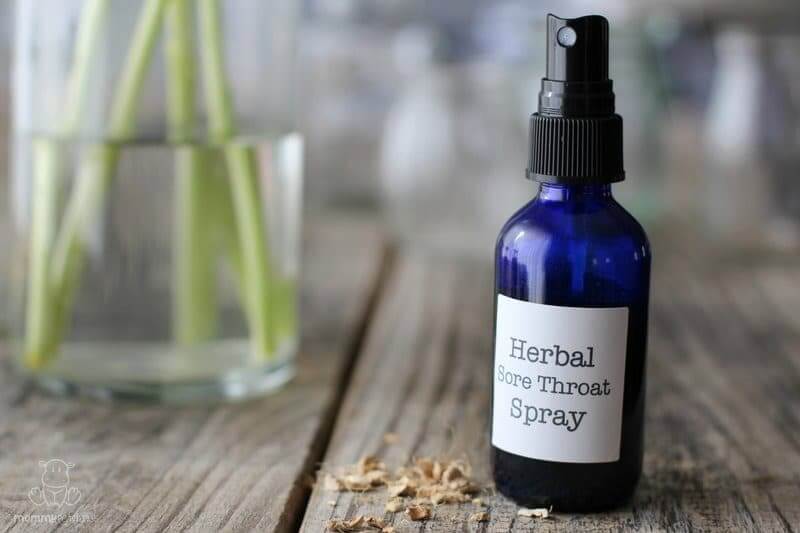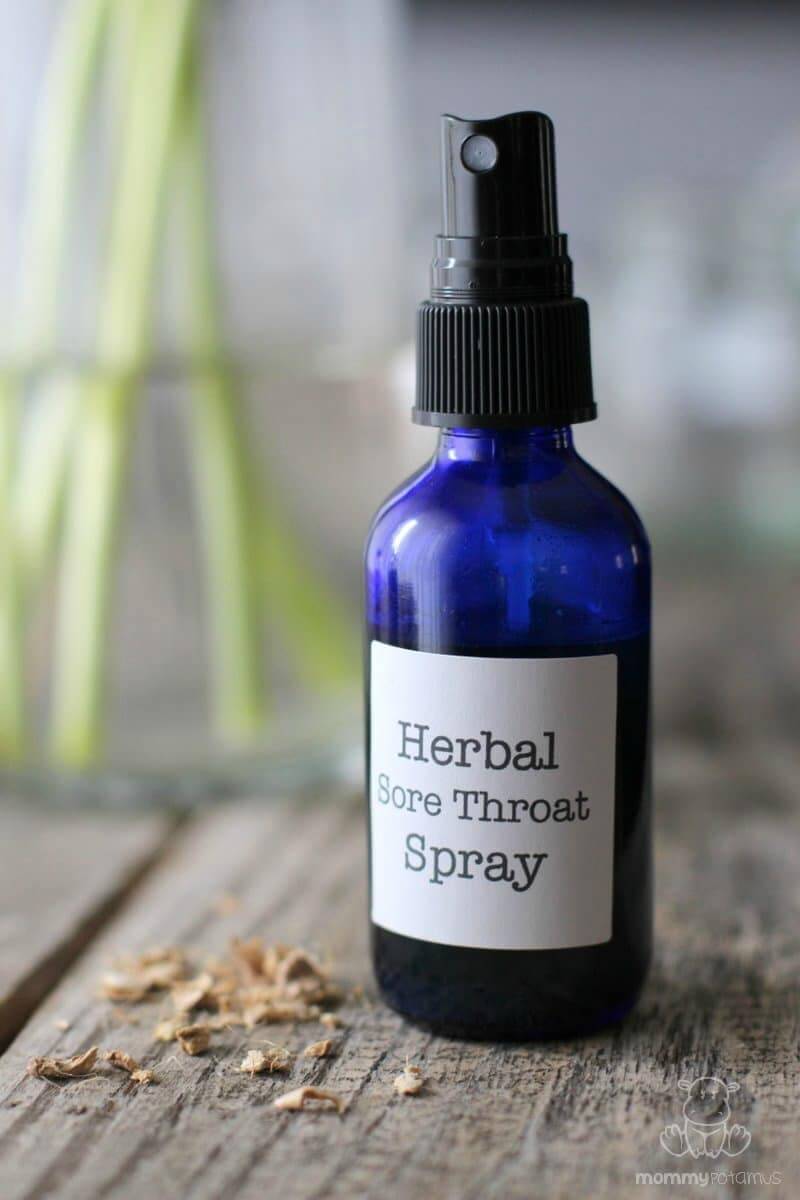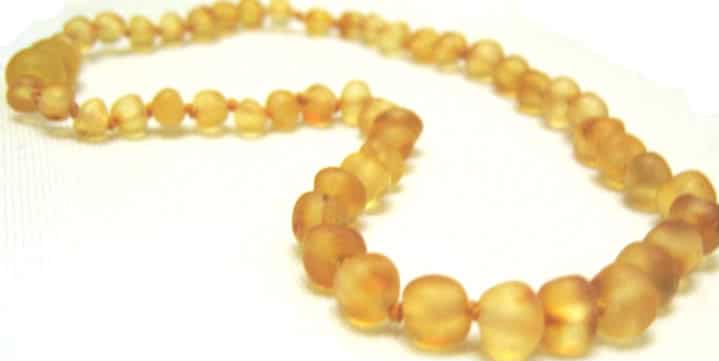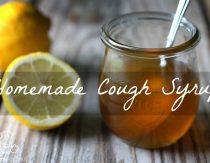
Earaches? Been there. Pinkeye? No problem. Fevers, coughs, and tummy aches? I’ve seen those, too. But the most common family health issue has to be sore throats.
Last week I noticed that my daughter’s voice dropped a couple of octaves, and then my son started feeling a little off – yep, sore throats! Fortunately, it was nothing an afternoon on the couch watching The Secret Garden and a soothing homemade throat spray couldn’t handle.
This recipe incorporates slippery elm bark, which takes on a silky, gel-like texture when heated. It’s long been used to coat and soothe sore throats, but it’s helpful to have on hand for other purposes, too.
If desired, you can add licorice root, which according to herbal folk wisdom can also be helpful for soothing sore throats. (Interestingly, modern research is exploring the potential benefits of licorice, too. In this study, they found that using licorice water as a gargle soothed patients throats after surgery.)
A pinch of cayenne – which contains capsaicin – is also a great addition for adults. It is thought to stimulate blood flow to the area, which supports the body’s natural healing processes. Flavorings such as warming ginger or soothing peppermint can also be added in.
What about using essential oils?
Because strep throat can sometimes lead to complications, when the potami developed sore throats I decided to take them to our family doctor and have them checked out. On my way, I messaged my friend Lea – essential oil safety advocate and founder of the Using Essential Oils Safely Facebook group – to ask what “big guns” she might suggest if the culture came back positive. I wanted some possible immune support strategies to discuss with our doctor just in case.
Lea suggested up to a 3% dilution of tea tree oil in water as a throat spray. That would be up to 9 drops per tablespoon of water or tea, shaken well before use. We didn’t end up needing it and I wouldn’t use it unless absolutely necessary, but I was thankful for her advice and wanted to pass it along. Like gargling, the tea tree in the spray would simply have contact with the back of the throat rather than being ingested.
I checked with her on what ages this would be appropriate for, and she said that as long as the child is old enough to cooperate with you spraying the back of the throat rather than on the tongue, it should be fine. Also, she said that an even better alternative to water would be to mix the tea tree with a little honey (to help it disperse better), and then add it to chamomile tea.

Homemade Herbal Throat Spray Recipe
Because this is not something my family needs often, I prefer to make it in small batches so that it doesn’t go bad. It’s technically a syrup according to the definition in Rosemary Gladstar’s Herbal Recipes For Vibrant Health, and therefore should last in the fridge for several weeks.
Ingredients
- 1½ teaspoons teaspoons whole slippery elm bark (find it here)
- 1/3 cup water
- 1/4 cup raw honey*
- pinch cayenne (optional, probably not the best idea for little ones)
- 1/2 teaspoon licorice root (this is what I use)
- Optional flavorings:
1/8 to 1/4 teaspoon peppermint extract
1/16 – 1/8 teaspoon dried ginger or 1½ teaspoons grated fresh ginger
*Honey is not recommended for children under one-year-old.
Instructions
Bring water to a boil and pour it over slippery elm. If using ginger or licorice, add it in as well. Allow to steep for 30-45 minutes, then strain the liquid well using cheesecloth. Stir in the honey and any flavorings you haven’t already added, such as peppermint extract. Pour the liquid into a clean spray bottle and store in the fridge when not in use.
Want more research-backed natural remedies?
No problem, I’ve created a free ebook for you – Kitchen Apothecary: 25+ Natural Remedies Using Ingredients From Your Pantry – as a gift for signing up for my newsletter. You’ll also get updates when I post about safe essential oils for pregnant/breastfeeding mamas, exclusive gifts and coupons (I was able to give away a jar of free coconut oil to anyone who wanted it recently!), plus other goodies.
Sign up using the form below.





On Mercola’s website it says yo never swallow or digest tea tree oil.
Yes, I definitely would not ingest tea tree. Lea, who is a certified aromatherapist who advises against ingestion of essential oils in general, says that this is not ingestion but rather like gargling. Just a small amount of essential oil will come into contact with the back of the throat.
I did hesitate to bring this up because it is quite a can of worms, but I found the information useful as something to discuss with my children’s doctor should there be a time when it might be appropriate. My preferred approach is to use herbs as described in the recipe above.
Thanks for addressing the tea tree oil issue – I know you’re not looking for a debate here. But I question the dilution rate you listed – I thought one drop of oil in one 5ml bottle is 1% dilution, so 9 drops in a tablespoon of water seems like way more than 3%. 9 drops would mean that the tablespoon holds three hundred drops of water; is my math wrong? Just asking because dilution always ties me up on recipes!
Also – I was wondering if using manuka honey instead of raw honey might add the tea tree benefits without the essential oil itself, in case anyone’s worried about that –
Hi Jennifer, I appreciate how you approached this question. You’re right, I am not looking for a debate! A 3% dilution is 3 drops per teaspoon of carrier. I have a chart I created for personal use and I’ve been meaning to publish it alongside a list of kid and pregnancy safe oils. In the meantime, here’s an article Lea wrote about dilution ratios: http://www.learningabouteos.com/index.php/2013/08/07/properly-diluting-essential-oils/
Manuka honey would be a GREAT option 🙂
Gah! Lea’s dilution chart is what I use, too, and clearly spatial awareness has never been my strength – I had no idea a 5 ml bottle was the same as a teaspoon. This is why I always measure and never guesstimate something! Thanks for reminding me about that chart –
Hi! Where can I find marshmallow root or slippery elm?
Oops! I meant to include that information in the post. Sorry about that, Jo. Just updated the recipe section with links to where I buy everything.
Thanks moooommy:)
I sure do enjoy your wisdom!
Hi! Is this recipe safe for pregant women? I am 26 weeks – thank you!
Licorice root, which is optional in this recipe, is not recommended during pregnancy. Regarding the primary herbs used in the recipe:
According to the Botanical Safety Handbook: 2nd Edition, which is the herbal equivalent of Robert Tisserand’s authoritative guide, Essential Oil Safety, slippery elm, and marshmallow root are classified as safety class 1 herbs. This category is described as:
“Herbs that can be safely consumed when used appropriately.
History of safe traditional use
No case reports of significant adverse events
with high probability of causality
No significant adverse events in clinical trials
No identified concerns for use during pregnancy
or lactation
No innately toxic constituents
Toxicity associated with excessive use is not a
basis for exclusion from this class
Minor or self-limiting side effects are not bases
for exclusion from this class”
Anything that has water in it needs a preservative. Why are you feeding your children bacteria soup, and advising others to do the same? This is negligent.
http://www.unesda.eu/lexikon/preservatives/
Hi Alex, according to renowned herbal expert Rosemary Gladstar, the high percentage of honey in this recipe extends the shelf life to several weeks if kept in the fridge.
Thank you mommypotomaus for this recipe .also I love Rosemary’s shop I go there constantly!
Hi, I used the right amounts of everything but mine is very gelatinous and definitely can’t be sprayed. Can you advise please?
I also made this with ground ginger, instead of fresh, marshmallow root boiled then strained, and honey. It will not spray. I have even added additional water to dilute it even more. Any suggestions?
Hello, I was wondering I wanted to make this spray but was not able to find whole slippery elm bark at my local health food store(I would have ordered online but I need it now). They did however have it ground. Can I use it in the ground form for this recipe or should I just use all marshmallow root? Thanks very much for this helpful recipe! It is so nice to be able to try natural remedies to heal before resorting to other methods.
Slippery elm bark is cheaper from Mountain Rose Herbs you get 4oz for $7.75 (10/24/18) instead of 1 for $7.25 on Amazon
I would have thought honey would make it too heavy to spray, but this worked well, thanks!